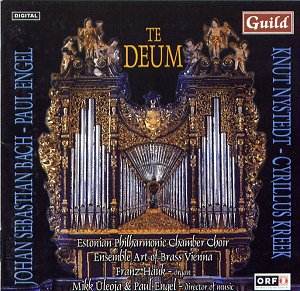I wouldn’t normally recommend hearing a CD with nine
works on it from beginning to end in one sitting. Indeed I did not at
first do so myself. However this is one of those rare CDs when hearing
the whole disc at a single session is a highly desirable thing to do
despite its seventy-minute duration.
Now and again a disc comes into a reviewer’s hands,
which at first may not seem to be too promising but which proves to
be exciting and fascinating. For me this has proved to be just such
a disc. It is beautifully planned, expertly recorded, staggering well
performed and in short a revelation. Guild is producing discs with a
considerably original profile. This is typical of the Guild stable,
including as it does two important composers, Engel and Kreek, little
known outside their own countries.
The programme is shaped at the beginning and end by
two major works by the Austrian composer Paul Engel. So the plan is:
a work for Brass of sixteen-minute duration by Engel followed by three
short psalm settings by Kreek for unaccompanied chorus. Then comes a
major Bach organ work and then a chorale prelude. There follows a choral
work dedicated to Bach by Nystedt and then the culmination of the entire
disc the 25 minute Te Deum for chorus, organ, brass and percussion
by Engel.
Let me put some flesh on the skeleton.
Engel’s work for brass is nicely entitled a ‘déjà-vu’
being based upon the Sonata XIII by Giovanni Gabrieli for eight instrumental
groups and also on the motet ‘Jubilate Deo’ I listened to both of these
pieces before preparing this review and I must say that the connections
are not obvious. However there are certain turns of melody and rhythm,
which are reminiscent of both works. Anyway Engel’s work is full of
interest and life even if slightly anonymous.
Cyrillus Kreek was an Estonian composer. If these psalm
settings are anything to go by then Kreek should be better known. He
is an ascetic composer, who wastes not a single note. These settings
are beautiful, simple and austere, inspired by the spiritual folksongs.
The collecting and cataloguing of folksong was a lifelong mission for
Kreek. The Estonian Philharmonic Choir is perfect for this music, well
balanced with a touch of that typical Northern European vibrato and
with strong dynamics.
The organ at St. Jakob’s Church, Innsbruck was reconstructed
by Johann Pirchner in 1999; its specification is given. The pedal board
is particularly impressive with an unusual 2¾ foot Mixtur VI. In my
view it is not really a Bach organ but its picture on the CD booklet
gives the impression of it being a baroque-inspired instrument. In any
case it’s a small point and the two pieces work well in a very agreeable
performance by Franz Hauk, who also contributes the booklet notes.
Knut Nystedt is Norwegian. He has been an invigorating
renewer in the field of church music in Norway. He has an individual
sound with his use of cluster chords and speech techniques in the 1960s.
Clusters are used in this work as it grows in intensity. More recently
neo-romantic elements have crept in and these are to be found in this
‘Homage to Bach’ using a chorale melody ‘Komm Susser Tod’.
Then comes Engel’s Te Deum where all of the
above musicians come together. This is a real masterwork. It divides
the text into four sections played without break. I am impressed by
its form, shape, overwhelming harmonic sense and growth, rhythmic excitement
and overall power. It leaves one spiritually uplifted. It is performed
as well as any composer might expect and quite obviously much enjoyed.
It is not too ‘modern’ and although tough it is not forbidding.
The booklet notes are useful if rather quaintly and
anonymously translated. I particularly enjoyed a description of the
end of the Te Deum, which describes the music as ‘lingering bells fuse
with wind and organ accords, which form a background for a large soprano
solo’. I make no further comment concerning fat ladies.
Gary Higginson
